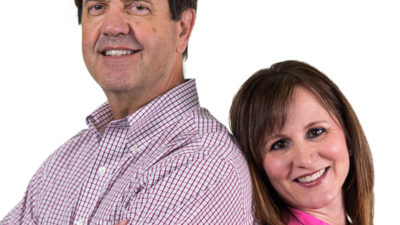Gardening Naturally with Jeff Ferris
 Saturday 9-11AM | Sunday 8-10AM
Saturday 9-11AM | Sunday 8-10AM
Jeff Ferris, hosts the longest continuously-running organic gardening talk show in the United States (and quite possibly the whole world!). GARDENING NATURALLY is unique in that it takes a non-chemical, environmentally sensitive approach to gardening. His goal is to teach homeowners about protecting the environment while enriching the soil to grow healthier plants. Jeff Ferris joined the show with previous host, John Dromgoole, as co-host in the fall of 2014. Together they brought many years of organic gardening experience to listeners calling in with their gardening questions. After John retired in early 2019, Jeff stepped in to take over as host.
Jeff Ferris has been a gardener in Austin for nearly 30 years. Jeff received his Permaculture Design Certificate in 2006 and has been teaching in the ACC Landscape and Horticulture program since 2008. Through their non-profit Neighborhood Harvest Project, he and his wife Lori co-founded the first public community garden in Round Rock – Unity Park Community Garden. Jeff has his own micro-farm and has been working at learning how to deal with the Texas soil and climate.
On Saturdays from 9 AM to 11 AM and Sundays from 8 AM to 10 AM, listeners call in with their questions about problems with trees, shrubs, lawns, flowers and vegetable gardens. Gardening Naturally has featured such guests as the late Robert Rodale, one of the definitive influences of organic gardening; Wallace Black Elk, a Native-American steeped in ancient traditions; and John Jeavons, world-famous bio-intensive farming expert. The astronaut, Eugene Cernan, shared his experience of the overwhelming effect of standing on the moon and looking back at earth while realizing how connected we are, and how we must take care of this planet. All guests are highly respectful of this planet and share in the vision of gardening naturally.
Call Into The Show:
512-836-0590
Don Gardner’s Watering Guidelines for Trees
Are your trees getting enough water to help them survive the drought? Longtime Consulting Arborist Don Gardner has developed a simple test to help you figure out how much water you should give your trees. All you need is a hand spade or small garden trowel.
- Water on your usual schedule (hose, soaker hose, sprinklers, whatever). If you haven’t been watering, start with an hour in each “zone” or area of coverage under the tree’s canopy.
- The next day, dig down about 5 inches deep with a garden trowel. Feel the soil at the bottom of the hole. The soil should be moist down to 5 inches. The soil should feel like the surface of a sponge that’s been thoroughly wrung out, not too wet or muddy. If it’s sopping wet, that’s too much. Cut back on your next watering day. If the soil isn’t moist at the bottom, add more time on your next watering day.
- Keep adjusting your watering time until you’re consistently getting the soil moist down to about five inches deep.
- After you’ve established the optimal length of time, you’re ready to cut back on the number of watering days. The number of days depends on the weather, temperature, site conditions and watering restrictions. Start with the following guidelines, using the five-inch soil moisture test to keep you on track. During cool weather (typically September – May), if there has been no significant rainfall, water deeply every two months. May through September, if there has been no rain, water deeply once a month. When the temperatures reach 100 degrees, water deeply every 2-3 weeks.
- Trees planted within the last two years need more frequent watering: September – May: Water weekly if no rain that week. June – August: Water 2-3 times per week if the water drains rapidly.
- Each time you water, move the sprinklers or hoses around under the tree so that the correct amount of water is applied everywhere under the canopy all the way to drip line. If water use is restricted, then cover only the area under the outer half of the canopy (from drip line to a point halfway between trunk and drip line) where most of the fine water-absorbing roots are located.
Don’s tips for watering:
- Don prefers a small, inexpensive, round, flat sprinkler: yellow metal, about six inches in diameter, with one hole that sprays a cone-shaped fountain up in the air.
- Set it to low flow so droplets are visible. Avoid turning the flow too high, as this creates a mist that evaporates quickly out of the air.
- The goal is even moisture. Bubblers, hose-end soaking and soaker hoses reduce evaporation, but they don’t distribute the water evenly over the root system.
- During very hot, dry weather, a thick layer of mulch can intercept most of the water before it reaches the ground. Old mulches can get crusty and even repel water. Break up the surface of the mulch or increase the water.
- Don recommends two inches of mulch, not three inches, for newly planted trees.
- Mature trees with mulch under them are more water-efficient than trees with grass.
Please note that these guidelines are for watering your trees, not your grass. Check with your lawn service or visit the City of Austin Water Conservation webpage to estimate your lawn watering needs.
Check out more KLBJ Specialty Shows
Listen Live to 99.7fm/590am News Radio KLBJ
Check out some local Austin news
Head back to the Home Page

7-27-21 Hour 1 Podcast
See omnystudio.com/listener for privacy information.

2-14-22 Hour 1 Podcast
See omnystudio.com/listener for privacy information.

4-1-22 HOUR 4
See omnystudio.com/listener for privacy information.

4-1-22 HOUR 4
See omnystudio.com/listener for privacy information.

Lionel Richie with Earth, Wind & Fire @ Moody Center
Sing A Song All Night Long Tour
